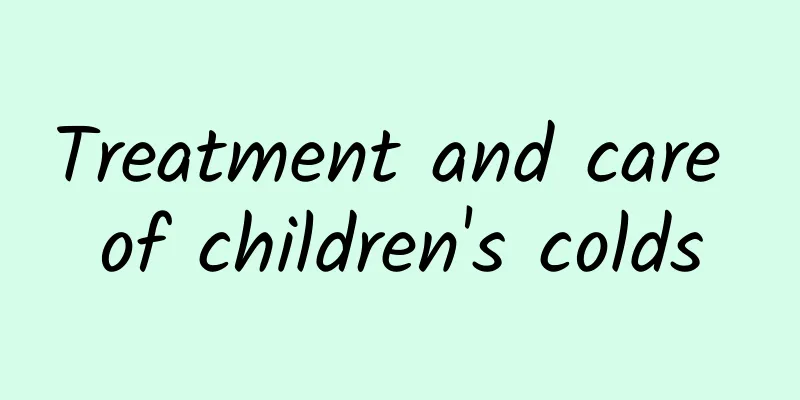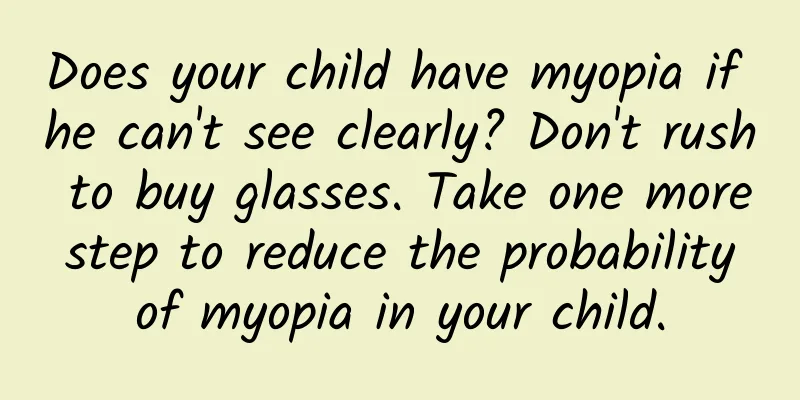Treatment and care of children's colds

|
1. What is a cold? Children often catch colds at the turn of the seasons, especially in winter and spring, and are mainly caused by viruses. At this time, if children catch a cold, are overly tired, or lack exercise, they may catch a cold. Colds are mainly characterized by catarrhal symptoms in the nasopharynx, and may include sneezing, nasal congestion, watery nasal discharge, and pharyngeal congestion. 2. Classification of colds Colds are divided into common colds and influenza. The differences between the two are as follows: 1) Symptoms: The common cold is mainly characterized by nasopharyngeal symptoms such as runny nose, nasal congestion, sneezing, and sore throat; the symptoms of influenza are more severe, mainly high fever, chills, and body aches. 2) Viruses: The common cold is mainly caused by rhinovirus (30-50%), followed by coronavirus (10-15%), respiratory syncytial virus (5%), etc. Influenza is mainly caused by influenza A and B viruses. 3. Treatment of colds in children The common cold is self-limiting to a certain extent. Children with mild symptoms only need to rest properly, drink plenty of water, and eat a light diet. Generally, it can heal itself in 7-10 days. Children with more severe symptoms need drug treatment. Drug treatment mainly focuses on antiviral and symptomatic treatment. Some Chinese medicines, such as Scutellaria baicalensis and Honeysuckle, have the effect of clearing heat and detoxifying. Western medicines such as oseltamivir can effectively resist influenza A and B viruses. These drugs are used in the early stage of a cold to effectively resist viruses and reduce the symptoms of a cold. Symptomatic treatment drugs, such as acetaminophen, an antipyretic and analgesic drug, can be taken during a cold to reduce headaches, limb pain and fever caused by the cold; pseudoephedrine hydrochloride can relieve congestion of the nasopharyngeal mucosa and reduce nasal congestion; chlorpheniramine can relieve sneezing symptoms, etc. Taking the above drugs during a cold can make our children more comfortable. 4. Nursing of children with colds Caring for a cold is very simple. Just remember one tip: wash your hands frequently, ventilate more, and don't go where there are many people. Drink plenty of water, get enough sleep, and eat fruits, vegetables, and milk. Exercise regularly and get enough rest, and don't catch a cold during the flu season. 5. How to wash your hands correctly Seven-step hand washing method: 1. Step 1 (inside): wash your palms with running water to wet your hands, apply hand sanitizer (or soap), palms facing each other, fingers together and rub each other; 2. Step 2 (outside): wash the back of the fingers, palms against the back of the hand, rub the fingers together, and exchange hands; 3. Step 3 (clamp): wash the palm of the fingers, palms facing each other, cross your hands and rub each other along the fingers; 4. Step 4 (bow): wash the back of the fingers, bend the joints of each finger, half-clench the fist, put the back of the fingers on the palm of the other hand and rotate and rub them, and exchange hands; 5. Step 5 (big): wash the thumb, hold the thumb of the other hand with one hand and rotate and rub them, and exchange hands; 6. Step 6 (standing): wash the fingertips, bend the joints of each finger, put the fingertips together in the palm of the other hand and rotate and rub them, and exchange hands; 7. Step 7 (wrist): wash the wrists and arms, rub the wrists and arms, and exchange hands. |
<<: Why do you feel empty after the "more than ten seconds of pleasure" that makes you want more?
Recommend
Is pelvic inflammatory disease adnexitis?
Pelvic inflammatory disease is a gynecological di...
The consequences of intercourse after taking suppositories
Vaginal suppositories are generally used to treat...
Female heel pain is a gynecological disease
Due to physical reasons, women are more likely to...
What are the ways to prevent breast sagging after childbirth?
Many women breastfeed after giving birth. After a...
Can a test strip detect pregnancy 16 days after intercourse?
Pregnancy test strips are the most economical and...
Reasons for light menstrual flow and yellow complexion
Menstruation is a process of physiological change...
Heel pain after exercise may be plantar fasciitis. What should I do?
As the Winter Olympics draws near, Huazi's fr...
Can severe fallopian tube obstruction be cured?
In modern society, with the increase of various w...
What should women pay attention to when taking care of their private parts after childbirth?
When a woman gives birth, whether through cesarea...
How to be good for the ovaries
The ovaries are very important to women's hea...
Kakao's game revenue forecast shows the future growth of WeChat games
Let's first look at the latest data of Kakao ...
Where is the cheapest Maxmara coat? When is the best season to buy Maxmara coat?
MaxMara coats are super popular, and many people ...
9 health risks that women should not ignore after marriage
Question 1: Menstrual syndrome Premenstrual syndr...
An article to teach you about mindfulness training
Author: Ren Feng Department of Psychiatry, Peking...
What happens to your body if you eat 1 bowl of rice noodles every day? Eating this way is healthier →
Rice noodles are a very popular delicacy in south...









